Jackie and I are in the midst of an apartment renovation, and during the delightful process of demolition we fled into the welcoming arms of a friend who lives just down the street. We enjoyed her hospitality, and I had the fun of cooking in a new kitchen equipped with an excellent Viking range - and of living only two blocks from our Wednesday farmers' market, as opposed to the seven I need to trudge when we're in our own place. At the market were some very promising-looking butternut squashes, and my thoughts turned, as they often do, to risotto.
I've been making risotto for decades, for much of that time using fairly rich chicken stock as my preferred cooking liquid. But in recent years, following the urging of my friends Angela Hartnett and Diego Cardoso of London's Murano restaurant, I've pretty much switched to light vegetable broth or much-diluted chicken stock, which return the spotlight to the star flavors of any risotto: shallots or onions, wine and, of course, rice. (It is too easy to forget that rice has a flavor of its own - and it is a lovely one.)
Something lacking in our friend's fridge was stock of any kind. I was about to make a pot of vegetable broth - and even considered using plain salted water - when my thoughts turned to Japan, where we ate quite a lot of squash during our visit in October. Considering rice and squash from that perspective, I realized that using Japanese flavors and Italian technique could yield a delicious result that, if I played my cards right, would not actually seem to be an Asian dish at all.
That train of thought also solved the stock problem: I'd use a dashi, the original instant broth. To make a quart of it, I soaked about 15 square inches of dried kombu seaweed in a little more than four cups of cold water, then slowly brought this to just under the boil. I turned off the heat, added a small handful of dried bonito shavings and let the pan stand off the heat for five minutes before straining it through a paper-towel-lined sieve. Don't worry if it smells fishy: the end result will not.
For three portions of risotto using a generous cup of carnaroli rice (other risotto rice can be substituted), I peeled the squash (ripe and smelling almost like a melon), cut some of it into roughly half-inch cubes - around two cups' worth, though precise quantities are not very important - and shredded some on a box grater, yielding a loosely packed cupful. The grated squash would melt into the risotto, joining with dashi and starch from the rice to form a creamy sauce and reinforcing the squash flavor: a good approach for many vegetable risottos.
I briefly sautéed the diced squash in a bare minimum of oil; by the time it had lightly browned, it was about 75 per cent cooked and could have been eaten as is. (A less ripe squash wouldn't have cooked so quickly.) I set this aside.
In the risotto pot (in this case an enameled cast iron casserole), I melted a tablespoon of butter and sweated half a medium onion, diced small, about an inch of peeled ginger root, minced, and the grated squash, all nicely salted. If I'd used oil, this would have been a vegan dinner. When the mixture was thoroughly tender but not browned, I stirred in the rice, cooked it for half a minute and added a quarter cup of white wine (I suppose I could have used sake, but the fruit-based flavor of wine was a better match with the squash). When this had reduced to nearly nothing, I began adding the dashi, warmed and salted, starting with 3/4 cup. From this point, I proceeded as with any risotto: vigorous stirring to break up the shredded squash and to promote creaminess; warm liquid added as needed. When the rice was nearly done, I added the sautéed squash cubes to finish cooking but made sure not to cook them to a mush: they remained slightly al dente.
At this point, I would normally have finished a risotto with butter and grated parmesan, but here I deployed another aged ingredient full of saltiness and savoriness: miso, that flavorful paste made of fermented soy and rice. I vigorously stirred in a generous tablespoonful, finally adding sufficient extra dashi (if I'd run out, water would have been fine) to ensure a risotto liquid enough to move around on the plate.
It worked! The dashi was light enough to let the flavors of rice, onion, ginger and squash stand out - a reminder of what a good pairing ginger and squash are. At the same time, it added a subtle hint of smokiness. The miso stood in for parmesan with great success. And it didn't taste Japanese, really. It didn't taste Italian either, but it looked so much like a normal risotto that it was easy to imagine that it was one - and one of the best we'd eaten in a while.
<
>
